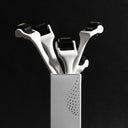When it comes to combating hair loss, understanding the differences between Nanoxidil and Minoxidil is crucial.
Both are effective ion-channel openers, but Nanoxidil is a newer compound with a slightly different molecular structure.
In this article, we'll explore how each works and which might be the better option for you.
Table of content
What is Nanoxidil?

Nanoxidil is a topical solution that has been shown to promote hair growth in both men and women with fewer side effects.
DS Laboratories Spectral DNC N contains 5% nanoxidil, azelaic acid and caffeine, among others.
One study (partly done by the people who sell nanoxidil) found that subjects who used nanoxidil experienced greater hair density and thickness than those who used minoxidil. However, more research is needed to confirm these findings. In the picture below, you can see the progression of the study.
If you're interested in trying nanoxidil, talk to your doctor to see if it's right for you.
As your leading source for hair health information over the past 4 years, we never compromise on accuracy. When it comes to your health, you deserve information you can truly rely on - and earning your trust is our top priority.
Here's how Scandinavian Biolabs ensures every piece of content meets the highest standards of accuracy and integrity:
- Credentialed Experts: Our reviewers are actively practicing doctors and medical researchers
- Stringent Reviews: Content undergoes rigorous editing by subject specialists and review by a practicing doctor.
- Evidence-Based: We rely on well-established research from trusted scientific sources like peer-reviewed journals and health authorities.
- Full Transparency: Our editorial standards, writer credentials, reviewer credentials, correction process, and funding are all publicly documented.
- Independent Voice: While we do promote products, we operate in a vacuum to business operations. Our main goal is just an unwavering commitment to providing medically-sound guidance.
You can count on Scandinavian Biolabs to consistently deliver the trustworthy health information you deserve. Read our Editorial Standards.
How does Nanoxidil work?
Nanoxidil treatment is thought to work by increasing blood flow and nutrient delivery to the hair follicle, which may help to stimulate hair growth. In addition, nanoxidil may help reduce inflammation and oxidative stress, which can contribute to hair loss.
What is minoxidil?
Minoxidil is a medication that is used as a treatment for male pattern baldness and female pattern baldness.
It's one of the two FDA-approved treatments for male hair loss.
Minoxidil is available in 2 concentrations: 2% and 5% minoxidil.
Minoxidil also comes in a variety of forms: topical minoxidil solution, minoxidil foam, oral minoxidil, minoxidil lotion etc.
When used correctly, minoxidil can be an effective treatment for receding hairline and hair loss.
How does minoxidil work?
Minoxidil works by dilating blood vessels and increasing blood flow to the scalp.
This helps supply nutrients to the hair follicles, promoting new hair growth.
In addition, minoxidil can help to preserve existing hair density and prevent further hair loss.
Nanoxidil vs Minoxidil: A quick comparison
Nanoxidil, a newer compound similar to Minoxidil, has a slightly different molecular structure with one less carbon chain. Both belong to ion-channel openers, but Nanoxidil is a more recent development.
While Minoxidil is FDA-approved to treat male pattern baldness, Nanoxidil's effectiveness is still under study.
| Feature | Nanoxidil | Minoxidil | Scandinavian Biolabs Hair Growth Routine |
|---|---|---|---|
| Active Ingredient | Nanoxidil | Minoxidil | Bio-Pilixin® Formula |
| FDA Approval | No | Yes | No (Not required) |
| Side Effects | Inconclusive | Some (e.g., dryness) | Minimal to None |
| Application Method | Topical Solution | Topical Solution | 3-step Routine (Serum, Shampoo, Conditioner) |
| DHT Blocking | Yes | No | Yes |
| Scalp Health & Hair Nourishment | Moderate | Moderate | High |
| Clinical Results | Limited Studies | Extensive Studies | Clinically tested |
| Suitable for Sensitive Scalps | Yes | Varies | Yes |
| Recommended Usage Frequency | Twice Daily | Twice Daily | Daily Routine |
| Vegan & Cruelty-Free | Varies by Brand | Varies by Brand | Yes |
| Money-Back Guarantee | Varies by Brand | Varies by Brand | 150-day Money-Back Guarantee |
Mechanism of Action
Both work by binding to adenosine triphosphate (ATP)-sensitive potassium channels to prolong the growth phase or anagen phase of the hair follicles.
However, nanoxidil's smaller molecular structure allows for deeper penetration into the dermal papilla than minoxidil. This targeted action may make it more effective for certain types of androgenetic alopecia.
Effectiveness
Clinical studies show minoxidil is effective for androgenetic alopecia across various Norwood-Hamilton scales when used as directed.
Nanoxidil shows promise in studies for female pattern hair loss and those unresponsive to minoxidil.
Both generally work best on receding hairlines and thinning crowns but individual response varies.
Application
Nanoxidil is applied once daily as a topical spray while minoxidil is applied twice daily as liquid, foam, or oral minoxidil.
Proper administration is important for both to achieve results.
Side Effects
Minoxidil does come with some side effects, ranging from mild ones to severe ones.
One minoxidil's potential side effect is scalp irritation, often due to its propylene glycol carrier.
Nanoxidil lacks research, so for now, we can say that it might have fewer side effects. Without propylene glycol, nanoxidil could help those sensitive to minoxidil.
However, minoxidil is better studied overall for side effects and is the safer choice.
Cost
Nanoxidil tends to be more expensive.
At the time of writing, only DS Laboratories Spectral DNC N contains 5% nanoxidil. DS Lab priced this nanoxidil at $40 or 43€.
Minoxidil is widely available with many options.
Is there a third option?
No, we're not talking about hair transplant.
Let's talk about a natural alternative to help your thinning hair: Scandinavian Biolabs Hair Activation Routine.
This cruelty-free, three-step system is where nature meets hair science.
Nature spent years trying to perfect the active ingredient for our hair growth routine, we're just borrowing it.
Free from synthetic drugs, it nurtures your scalp and fosters hair growth with potent botanical extracts and nutrients.
Why worry about the side effects of drugs when you can go the natural route?
And it's not like it's not science-backed.
Just look at our clinical study results!

What really sets us apart? Our commitment to nature ensuring you avoid drug-related side effects.
Plus, with our 150-day money-back guarantee, it's all gain, no pain.
No drugs, no drama, just nature working its magic on your hair!
Conclusion
These hair loss treatment options - Spectral DNC with 5% nanoxidil or 5% topical minoxidil are both potential ways to treat your hair loss and encourage hair regrowth.
The primary differences are higher absorption rates, fewer side effects, and higher prices.
For those who seek a natural, multifaceted approach to healthier hair, Scandinavian Biolabs contains Capilia Longa, an active ingredient with plant hair growth promoters that's shown in studies to help improve hair density and reduce hair loss.
Read more:







